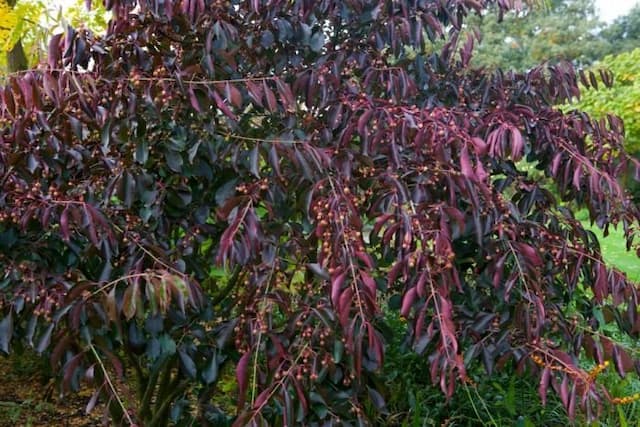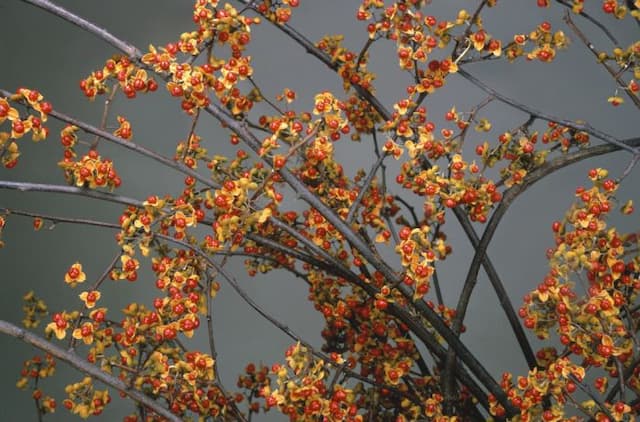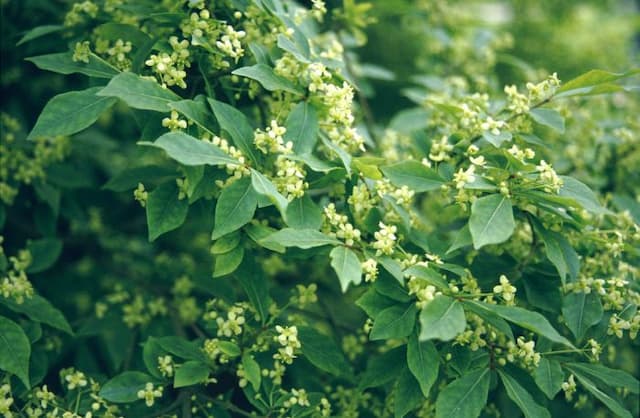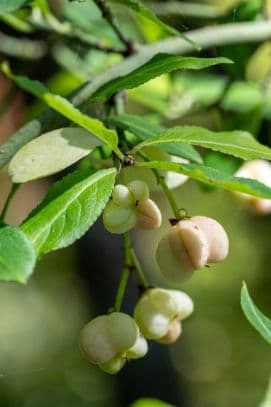Burning Bush Euonymus alatus 'Timber Creek'
ABOUT
The Euonymus alatus 'Timber Creek', commonly known as the burning bush, is noted for its distinctive appearance, particularly in the fall. This deciduous shrub is renowned for its vibrant foliage which transitions into an eye-catching fiery red color as the season progresses, creating a spectacular display in gardens and landscapes. The branches hold small, inconspicuous flowers that are greenish in hue, usually appearing in spring. Adding to its decorative appeal, the plant's stems exhibit prominent cork-like ridges that give the branches a winged appearance, from which the common name 'winged euonymus' also derives. This texturing on the stems adds visual interest even when the shrub is not in leaf. The leaves of the burning bush are of an oval shape, coming to a sharp point, and organized in an opposite leaf arrangement along the stems. During the growing season, the leaves are a lush green and provide a dense, bushy backdrop for other plants. As the leaves change color in the fall, they stand out starkly against the plant's own branches and stems, as well as the general landscape. The burning bush also produces a fruit that starts as a green capsule and then matures to a reddish color, splitting open to reveal seeds which are surrounded by an orange aril (a specialized outgrowth that partially or fully covers the seed). The overall aesthetic of the plant is one that can be described as compact and rounded, with a neat, yet slightly irregular, silhouette that lends itself well to being used for visual structure within a garden. While this plant offers tremendous visual interest, it's important to note that in some areas it is considered invasive and its planting is discouraged or regulated.
About this plant
 Names
NamesFamily
Celastraceae.
Synonyms
Burning Bush, Winged Spindle, Winged Euonymus.
Common names
Euonymus alatus 'Timber Creek'.
 Toxicity
ToxicityTo humans
Burning bush is considered toxic due to the presence of alkaloids among other compounds. If ingested, parts of this plant, especially the seeds, can cause symptoms such as nausea, vomiting, abdominal pain, weakness, and in severe cases, cardiac complications could occur. It is advised to seek medical attention if ingestion is suspected.
To pets
Burning bush is also toxic to pets like dogs and cats. Ingesting parts of the plant can lead to symptoms similar to those in humans, including vomiting, diarrhea, weakness, and potentially more serious symptoms like changes in heart rate or rhythm. If a pet ingests this plant, it is important to contact a veterinarian promptly.
 Characteristics
CharacteristicsLife cycle
Perennials
Foliage type
Deciduous
Color of leaves
Green
Height
6 feet (1.83 meters)
Spread
6 feet (1.83 meters)
Plant type
Shrub
Hardiness zones
4
Native area
Asia
Benefits
 General Benefits
General Benefits- Ornamental Appeal: Euonymus alatus 'Timber Creek', or burning bush, is known for its vibrant red foliage in the fall, which provides a striking visual display.
- Low Maintenance: The burning bush is a hardy plant requiring minimal care once established, making it ideal for gardeners seeking low-maintenance landscaping options.
- Wildlife Habitat: It can provide shelter and food for wildlife, including birds and small mammals, contributing to the biodiversity of the area.
- Drought Resistance: Burning bush is tolerant of drought conditions once established, making it suitable for regions with water restrictions or low rainfall.
- Erosion Control: Its root system can help stabilize soil and prevent erosion, particularly on slopes or in areas with loose soil.
- Adaptability: The burning bush can thrive in a variety of soil types and environmental conditions, making it a versatile choice for different landscapes.
- Year-Round Interest: In addition to its autumn color, the plant has interesting winged stems that add texture to the winter landscape.
- Privacy Screen: When planted in groups or rows, burning bush can serve as an effective privacy screen or hedge throughout the year.
 Medical Properties
Medical PropertiesThis plant is not used for medical purposes.
 Air-purifying Qualities
Air-purifying QualitiesThis plant is not specifically known for air purifying qualities.
 Other Uses
Other Uses- Compact burning bush twigs can be used in miniature crafting, such as for making fairy garden furniture due to their interesting texture and durability.
- The vibrant fall foliage of compact burning bush can be pressed and used in botanical arts and crafts, such as in creating natural bookmarks or in scrapbooking.
- Wildlife habitat creation can be enhanced using compact burning bush, as birds may nest in the dense branches during the spring and summer months.
- Photographers and artists may utilize compact burning bush as a subject or backdrop for autumn-themed photography and paintings because of its vivid red foliage.
- When pruned, the dense branches of compact burning bush can be used to create natural privacy screens or garden mazes in landscape design.
- The wood of compact burning bush, being dense and hard, can be used for carving small objects like pendants or ornamental figures by woodworking enthusiasts.
- During winter, the stark, winged branches of compact burning bush can provide visual interest in otherwise barren gardens, useful in landscape aesthetics.
- Compact burning bush can be used in educational settings, such as schools or nature centers, to teach about deciduous plant life cycles and seasonal changes.
- Its resistance to many pests and diseases makes compact burning bush a useful case study plant for horticulture students learning about plant health management.
- Enthusiasts of natural dyes may experiment with the leaves of compact burning bush to create dyes for fabrics or paper, leveraging the pigments that give the leaves their autumn color.
Interesting Facts
 Feng Shui
Feng ShuiBurning Bush is not used in Feng Shui practice.
 Zodiac Sign Compitability
Zodiac Sign CompitabilityBurning Bush is not used in astrology practice.
 Plant Symbolism
Plant Symbolism- Change and Transformation: The foliage of Burning Bush (Euonymus alatus 'Timber Creek') transforms dramatically during autumn, turning vibrant red before falling away. This symbolizes life's constant changes and the natural cycles of transformation.
- Attention and Warning: The striking and almost flame-like colors of the Burning Bush in autumn are hard to miss. Historically, vibrant colors in nature have served as warnings or attracted attention, symbolizing caution or signaling importance.
 Water
WaterThe Burning Bush should be watered deeply at planting time and then once a week with about 1 inch of water during the first growing season to help establish a deep root system. After the first year, reduce the frequency to every two to three weeks. During prolonged dry spells or extreme heat, increase watering to prevent stress, providing 1 to 1.5 gallons per week. Ensure the soil around the plant is moist but not waterlogged, as too much water can lead to root rot.
 Light
LightThe Burning Bush thrives in full sun to partial shade conditions. Ideally, locate the plant where it receives at least 6 hours of direct sunlight each day. It can tolerate some shade, but too much will reduce the intensity of the plant's famous fall coloration.
 Temperature
TemperatureThe Burning Bush is hardy and can withstand a wide temperature range, from winter lows around -30°F to summer highs well into the 90s°F. The ideal temperature for promoting vigorous growth and the best fall color is between 60°F and 70°F.
 Pruning
PruningPrune the Burning Bush to shape and maintain its size or to remove any damaged or diseased branches. The best time for pruning is late winter or early spring before new growth starts. Pruning can be done annually, or as needed to keep the plant tidy.
 Cleaning
CleaningAs needed
 Soil
SoilBurning Bush prefers well-draining soil with a pH ranging from 6.0 to 8.0. A mix of loam, sand, and organic compost often creates an ideal growing medium, offering adequate drainage and fertility.
 Repotting
RepottingBurning Bush rarely needs repotting as it is commonly planted in the ground, but container-grown specimens may require repotting every 3-5 years to refresh the soil.
 Humidity & Misting
Humidity & MistingBurning Bush is tolerant of a wide range of humidity levels and does well in the average ambient outdoor humidity, without requiring any special adjustments.
 Suitable locations
Suitable locationsIndoor
Provide bright indirect light and occasional water.
Outdoor
Plant in sun or partial shade, well-drained soil.
Hardiness zone
4-8 USDA
 Life cycle
Life cycleThe life cycle of Euonymus alatus 'Timber Creek', commonly known as the Burning Bush, begins with seed germination, typically occurring in spring when the soil temperature warms up. The seedlings develop into juvenile plants and focus on establishing a strong root system and foliage growth. As the plant matures, it enters the vegetative stage, where it continues to grow leaves and stems, becoming a dense, multi-stemmed deciduous shrub. Upon reaching maturity, the Burning Bush enters the reproductive stage, producing small greenish flowers in late spring to early summer. Following pollination, the flowers give way to small, reddish fruits that mature in autumn, coinciding with the plant's most striking feature, the vibrant red fall foliage. The seeds from the fruit are then dispersed, often by birds, completing the cycle and leading to the development of new plants.
 Propogation
PropogationPropogation time
Early Spring
The Euonymus alatus 'Timber Creek', commonly known as Burning Bush, is typically propagated using softwood cuttings. To achieve this, cuttings are often taken in late spring or early summer when new growth is still supple. A stem segment of about 4 to 6 inches (10 to 15 centimeters) is cut just below a leaf node, and the lower leaves are removed. The stem end is then dipped in rooting hormone to encourage root development and is inserted into a moistened mix of peat and perlite or sand. The cutting should be kept at a consistent humidity level by covering it with a plastic bag or placing it in a propagator, and it should be kept out of direct sunlight until roots have established. This can take several weeks. Once rooted, the new plant can be transferred to a pot with standard potting mix to continue growth.






![Spindle [Blondy]](/_next/image?url=https%3A%2F%2Fplants-admin.emdemapps.com%2Fimages%2Fplants%2F%2Fimages%2F604b642f54add.png&w=640&q=75)
